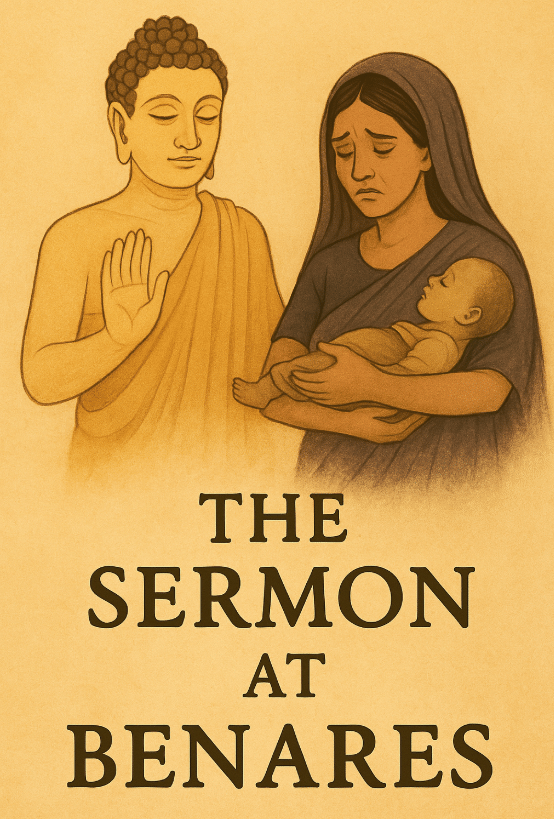Class 10 English Chapter 1 Question Answers - First Flight
Introduction
The Sermon at Benares by Gautama Buddha reflects his wisdom and understanding about human suffering and the impermanence of life. In this lesson, the Buddha shares profound insights with Kisa Gotami, a grief-stricken mother who learns valuable lessons about life, death, and acceptance. This chapter highlights the universal nature of death and the path to peace through acceptance.

Q1. The life of mortals in this world is troubled and brief and combined with pain. With this statement of the Buddha, we find the moral value that Kisa Gotami learned after the loss of her child.
Ans:
According to the Buddha, all humans are mortal, and death is inevitable for everyone. The Buddha teaches that life is filled with pain, trouble, and sorrow, and is brief. The Buddha's statement reflects the reality that no one, young or old, can escape death. Kisa Gotami, after losing her son, was initially consumed by grief and sought ways to bring him back to life. The Buddha instructed her to collect mustard seeds from a house where no one had died. Through her search, Kisa Gotami learned that death is a common experience for all. Her grief turned into self-awareness, and she realized that true peace comes from letting go of selfishness and accepting the inevitability of death. This was the lesson Buddha wanted her to understand.
Q2. Why did Kisa Gotami understand the message given by the Buddha only the second time? In what way did the Buddha change her understanding?
Ans:
Initially, Kisa Gotami was overwhelmed by her personal loss and could not see beyond her grief. She believed that her son's death was an isolated tragedy. During her second visit, Buddha instructed her to collect mustard seeds from a house where no one had died. As she went from house to house, she discovered that every family had experienced the loss of a loved one. This realisation opened her eyes to the fact that grief is universal and that everyone faces loss. Buddha helped her shift her perspective, making her understand that true peace comes from accepting death as part of life, not from clinging to selfish grief.
Q3. The Buddha said, "The world is affected by death and decay, therefore the wise men do not grieve, knowing the terms of the world." Do you think the statement is appropriate even for today’s life? Write your views in the context of the above statement.
Ans:
The Buddha’s statement remains relevant in today’s world. He teaches that death is inevitable, and it is a part of life’s natural cycle. Just like fruits that ripen and eventually fall, humans too are subject to death. Grief and mourning cannot bring back the deceased; they only lead to more pain and suffering. In the modern world, people often strive to accumulate wealth and possessions, neglecting the truth that life is temporary. If people could accept the reality of death, they would find peace. Mourning, while natural, should not lead to perpetual sorrow. We must learn to let go and embrace life with all its challenges.
Q4. Through the story of Kisa Gotami, what did the Buddha try to preach to the common man?
Ans:
Through the story of Kisa Gotami, the Buddha preached the universality of death and the importance of acceptance. He taught that death is a common fate for all living beings. Kisa Gotami, in her grief, believed that her loss was unique, but Buddha showed her that every family experiences loss. He also emphasized that selfish grief only leads to more suffering. True peace is achieved when one accepts the reality of mortality and stops mourning endlessly. Buddha’s message is clear: death is unavoidable, and we must learn to accept it to achieve freedom from sorrow.

Q5. What impression do you form of Lord Buddha after reading the lesson, The Sermon at Benares?
Ans:
After reading this lesson, Lord Buddha appears as a wise and compassionate teacher. His teachings are based on the acceptance of reality, and his approach to suffering is deeply profound. Buddha’s ability to provide solutions to deep human suffering shows his great wisdom. His message is clear: suffering is a part of life, and it can be overcome through detachment, acceptance, and self-awareness. Buddha’s first sermon at Benares outlines the Eightfold Path, which guides people toward overcoming suffering and attaining peace of mind. His teachings continue to inspire millions to live a life free from suffering.
Q6. Who was Gautama Buddha? What made him renounce his royal life and become a monk?
Ans:
Gautama Buddha, originally known as Siddhartha Gautama, was born into a royal family in northern India in 563 BCE. He lived a luxurious life with his family but was shielded from the harsh realities of the world. At the age of twenty-five, Siddhartha saw a sick man, an aged man, a funeral procession, and a begging monk during his travels. These experiences deeply affected him and made him realize the suffering present in the world. Moved by these sights, Siddhartha decided to renounce his royal life and embark on a quest for spiritual knowledge. After years of meditation, he attained enlightenment and became known as Buddha, the Enlightened One.
Q7. Why did Kisa Gotami go to every neighbour? Why did she say, ‘How selfish I am in my grief’?
Ans:
After the death of her son, Kisa Gotami was devastated and carried her child to every neighbour, asking for medicine. The neighbours, however, thought she had lost her senses. They could not offer her anything to help. When Kisa Gotami met the Buddha, he instructed her to find mustard seeds from a house that had never experienced loss. As she went from house to house, she realized that every family had faced loss. This made her understand that death is an inevitable part of life. She realized that her grief was selfish, as she was focused only on her personal loss, while death is a universal experience. This understanding shifted her perspective, and she recognized that mourning forever is futile.
Q8. What did the Buddha ask Kisa Gotami to do? Why couldn’t Kisa Gotami succeed in getting a handful of mustard seeds from any family?
Ans:
The Buddha instructed Kisa Gotami to bring him mustard seeds from a family where no one had died. She went from house to house, hoping to find such a family, but in each home, she learned that someone had passed away. This realization left her exhausted and hopeless. She understood that death is a shared experience among all living beings and that everyone, regardless of their status or wealth, faces loss. Through this lesson, Kisa Gotami learned that grieving alone does not change the reality of death. She learned to accept death as a part of life.
Q9. Describe the main teachings of the Buddha as highlighted in The Sermon at Benares.
Ans:
In his first sermon at Benares, Buddha taught that suffering is a part of human existence, and death is inevitable for all living beings. He explained that grief over the death of loved ones is natural, but it cannot change the inevitable truth of death. Buddha emphasized that the key to peace of mind is to accept death as a universal experience. Through his Eightfold Path, Buddha showed how one can overcome suffering and achieve enlightenment. He also taught that selfish grief only leads to more suffering, and true peace comes from letting go of selfish desires and embracing the natural course of life.
Q10. What does the Buddha say about the life of mortals in this world? How can one obtain peace of mind?
Ans:
The Buddha explains that mortals are subject to death, and life is often troubled and brief. Death is inevitable and is a part of the natural cycle of existence. The Buddha compares life to ripe fruit that will eventually fall, and earthen pots that are bound to break. The wise do not grieve because they accept that death is a universal reality. Grieving excessively only leads to more pain and suffering. To achieve peace of mind, one must let go of lamentation and grief. By overcoming sorrow and accepting mortality, one can attain a state of blessedness and freedom from suffering.
Key Vocabulary Box:
Afflicted: Suffering from illness or distress.
Lamentation: Expressing grief or sorrow.
Procure: To obtain or acquire.
Desolation: A state of emptiness or devastation.
Composed: Calm and self-controlled.
Selfishness: Concerned only with one's own interests, often at the expense of others.
|
61 videos|812 docs|69 tests
|
FAQs on Class 10 English Chapter 1 Question Answers - First Flight
| 1. What is the main message of the Sermon at Benares? |  |
| 2. What are the Four Noble Truths discussed in the sermon? |  |
| 3. How does the Eightfold Path aid in overcoming suffering? |  |
| 4. Why is the Sermon at Benares considered significant in Buddhism? |  |
| 5. What impact did the Sermon at Benares have on the followers of Buddha? |  |






















